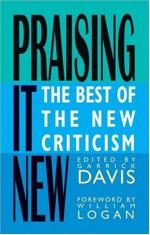|
This section contains 3,309 words (approx. 12 pages at 300 words per page) |

|
SOURCE: Raleigh, John Henry. “The New Criticism as an Historical Phenomenon.” Comparative Literature 11, no. 1 (winter 1959): 21-28.
In the following essay, Raleigh comments how New Criticism as a historical phenomena was composed of contradictions, and a great part of its success arose precisely out of this many-sidedness, which lent to the whole movement complexity and power.
The era of the New Criticism, everyone agrees, is over. Its beneficial effects, which are many, will we hope be permanent—its sins interred with its bones. One of the founders, T. S. Eliot, has already written an apologia and an historical analysis of the movement as a whole.1 According to Eliot, it was the method and attitude of Coleridge, the first great critic in English to employ such extraliterary disciplines as philosophy, aesthetics, and psychology in the study of literature, that has stimulated the extraliterary interests of modern criticism in the social...
|
This section contains 3,309 words (approx. 12 pages at 300 words per page) |

|


